Matiari's schools are in a true state of emergency
Buildings of 96 primary and six secondary schools in the district have been termed 'unsafe'
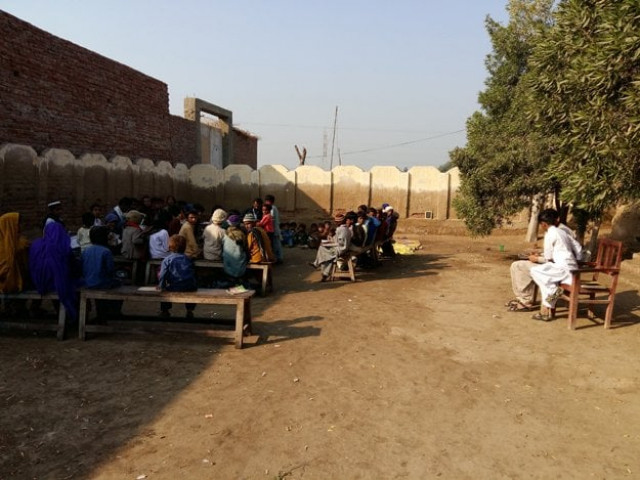
The students are studying in the open air, braving both hot and cold weather instead of studying indoors where some of their classmates have been injured by falling plaster. PHOTO: EXPRESS
The students and their three teachers brave the summer heat and winter chill in the open. The boundary walls and a tall wall of a nearby residential structure block the sun's rays only for a few hours in the morning. The students and teachers spend the rest of the day perspiring.
Up to 123 children of Mir Muhamamd Gahothi village are enrolled in this primary school, which started in 1999 in a newly constructed two-room structure. However, around three years ago, plaster began to fall from the ceiling and cracks appeared in the walls. A student also sustained minor injuries due to falling plaster.
Since then, according to Head Teacher Amin Gahothi, classes are conducted in the veranda. "Many judicial and education officials have visited the school, assuring immediate reconstruction but we are still waiting to see the work start," he tells The Express Tribune.
In the absence of blackboards, the three primary teachers, including Gahothi, can only read out loud from textbooks to help their pupils understand different subjects. "For early schooling, we don't have an alternative to blackboards for effective teaching," laments Gahothi.
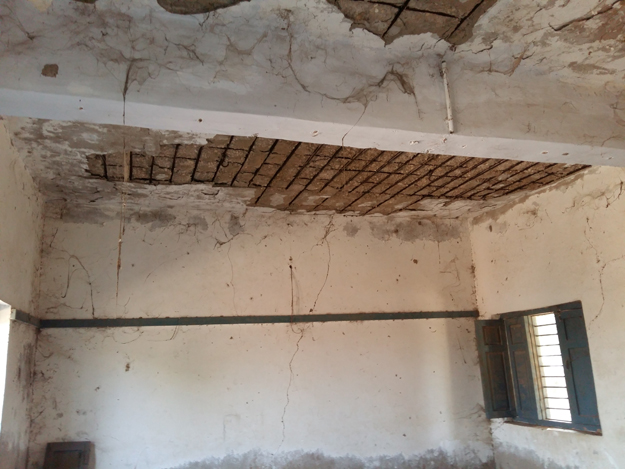 A ceiling of a schoolroom whose plaster has fallen. PHOTO: EXPRESS
A ceiling of a schoolroom whose plaster has fallen. PHOTO: EXPRESSThe school neither has electric supply nor water. Without water, the two toilets built along the outer wall are useless. "The school's building has expired. The authorities have been asked [to restore it]," reads a December, 2015, note of a primary education supervisor in the school register. Former Saeedabad taluka assistant commissioner Soomar Sheedi also wrote that reconstruction was required on 'war footing'.
Only around 60 students attend the school regularly. "Lack of facilities stymie our efforts to maintain attendance and increase enrolment by convincing parents to send their children," says Gahothi.
Similar cases
This is not the only school in the area that holds classes under the blazing sun. Many other schools are in a similar state.
According to Khadim Jamali, president of the Government School Teachers Association (GSTA), Matiari, there are dozens of similar schools in his district and thousands in the province. "Every year tens of millions of rupees are allocated and released for the repair and rehabilitation of schools in Matiari. But I have yet to see the place where that money has been spent," he tells The Express Tribune. "Innocent children are forced to study in tumbledown school structures due to the apathy and corruption of officials," he says, adding that a sum of Rs220 million was earmarked for the district in 2017-18 for repair and rehabilitation works.
 Water is not adequately available at many schools in Matiari. PHOTO: EXPRESS
Water is not adequately available at many schools in Matiari. PHOTO: EXPRESSIn another village of Saeedabad, an educational facility was founded in 1953 as a primary school and elevated to an elementary school in 1983 and high school in 1999. It also continues to operate in a ramshackle structure. The Government Bagho Khan Jamali High School, which is functioning in three separate buildings, has an enrolment of 571 students with an impressive attendance, says Principal Wazeer Ali.
The village consists of around 700 households, according to an elder, Mohammed Bachal Jamali. Students seeking college education have to travel to Hala taluka, 12 kilometres (km) away, or to Matiari taluka, which is 35 km away from the village.
The ceiling of one of its classrooms collapsed during rainfall in 2011 and has not been rebuilt since then. The plaster on the ceilings and walls of other rooms as well as the corridor is also caving in, while the floor is marked by protruding rough-hewn edges of earth and concrete.
"We build boundary walls of our homes with mud but they never fall, unlike school buildings [which are made of concrete]," the elder explains.
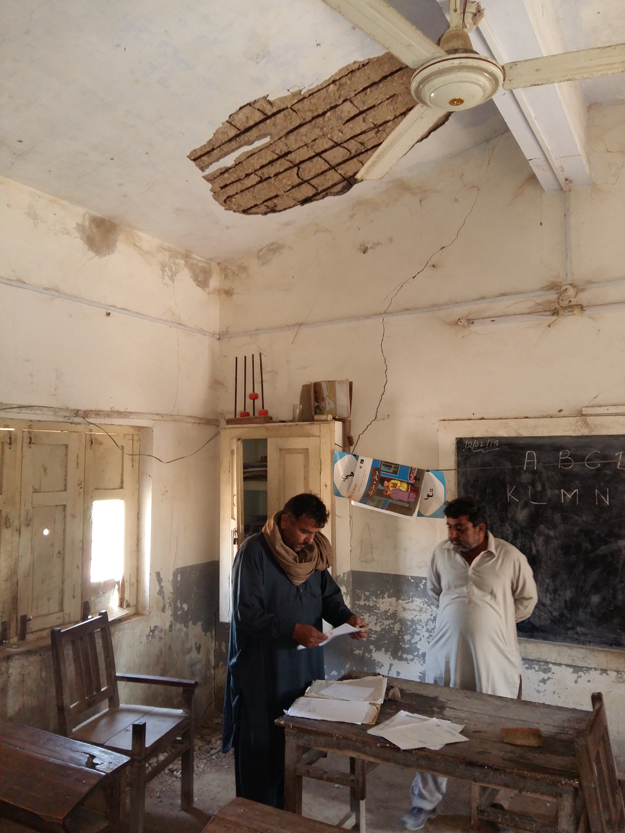 A dilapidated classroom at a school. PHOTO: EXPRESS
A dilapidated classroom at a school. PHOTO: EXPRESSA letter written in 2006 by the then works and services district executive officer estimated the cost of repairs to be Rs26.36 million. The cost included around Rs2 million for the main building and the remaining for the boundary wall, main gate, toilets and other works. The project was reportedly approved but still awaits execution.
"The school hasn't received new furniture for the last 10 years," claims senior teacher Muhammad Deen Jamali. "We have been requesting renovation and reconstruction since 2003."
A government girls' primary school in the vicinity, initially constructed in 1974, is now providing education to 107 female students in two rooms built by a non-governmental organisation over a decade ago. However, fissures have developed in the walls of the new building as well. Salinity has stripped the paint from the walls.
Matiari residents protest against dilapidated schools in the district
At a government boys' primary school in Meeranpur village of Hala taluka, enrolment dropped from 300 to 130 as plaster began to fall apart four years ago and a child, Bilawal Khaskheli, was injured. According to the head teacher, Zaheer Ali Memon, the school was built 17 years ago. He echoed similar grievances about indifference of officials who take no steps to repair the building despite being aware of the perils.
Model school?
In Sher Muhammad Thora village, a girls' primary school was built in 1998 with many rooms. The objective was to provide separate classrooms of considerable size for each of the six classes from kindergarten to the fifth grade, as well as separate rooms for teachers, the head teacher and administration. A playground, water tank with four taps, three lavatories and a boundary wall were also constructed.
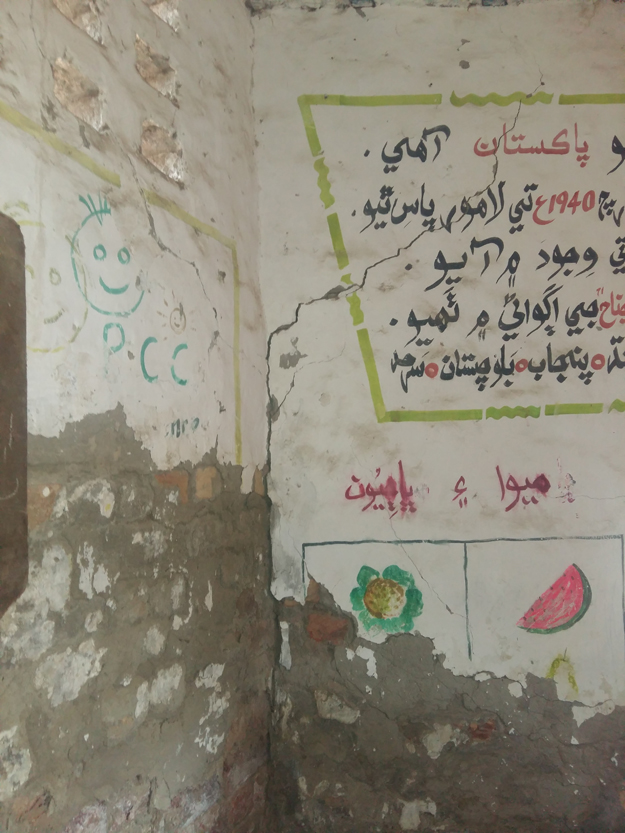 A wall with cracks whose paint has peeled off. PHOTO: EXPRESS
A wall with cracks whose paint has peeled off. PHOTO: EXPRESSIn 2002, it was given the status of a community model school. Yet, the facility was never provided electricity or water.
Decay in the school structure that began in 2000 after a breach in the Rohri Canal drowned the school, eventually left three rooms unusable by 2010 as plaster on the ceiling and walls kept falling.
"Meanwhile, the water and electricity problems remained unaddressed. The teachers and students brought drinking water from homes, and if the need for using toilets arose, there was no other choice but to return home," says a teacher, requesting anonymity. The school is also in need of new furniture as it has received none since 2002.
The village's high school, where 570 students are currently enrolled, presents a somewhat identical picture of unfinished construction and utility works. The government began constructing a six-room ground-plus-one structure in 2007. From 2008 to 2012, the work slowly progressed after which it seems to have permanently stopped.
"The plan was to shift students of grades six to 10 to the new building so that primary level students could be better accommodated in the old building," a teacher says, requesting anonymity. "We also planned to set up a laboratory and library in the vacant rooms."
The students and teachers have been in limbo since a conflict was reported between the builder and education officials. The protracted delay in flooring, electric fitting, doors, windows and paint works has made the new structure useless.
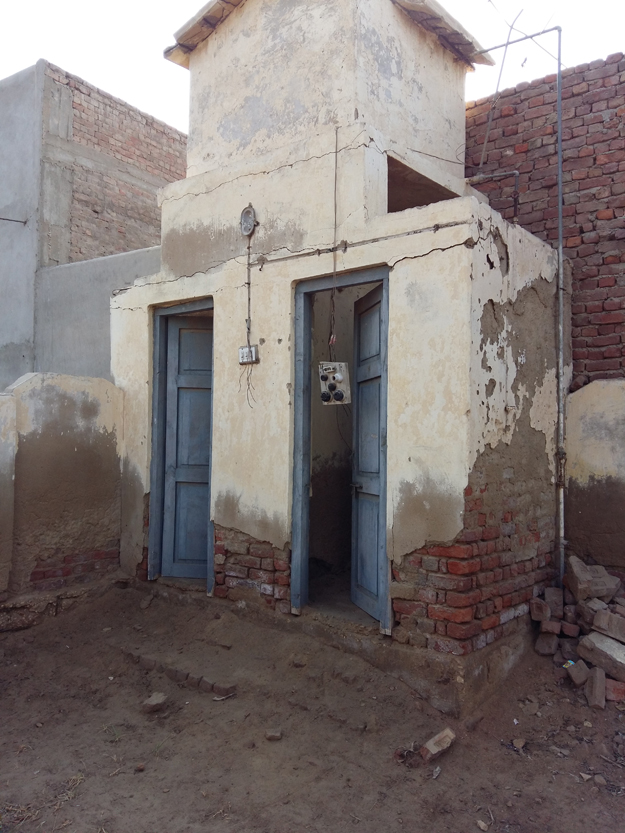 Toilets at many schools are useless due to non-availability of water. PHOTO: EXPRESS
Toilets at many schools are useless due to non-availability of water. PHOTO: EXPRESSStatistics
According to a recent report which the Matiari education department submitted to a local court, of 917 primary schools in the district, 96 buildings are dangerous. As many as 10,839 students are enrolled at these 96 schools. The enrolment at 10 of these schools ranges between 320 to 905 students. The remaining 162 schools in Matiari require major repair works.
SHC seeks data on government schools
There are 77 elementary and higher secondary schools in the district, including six whose buildings have been termed unsafe. Two of them are damaged and eight are partially damaged while 21 require major repairs.
The Sindh Education Profile 2016-17, which was released in January this year, states that 5,998 is the number of unsafe school buildings in the province.


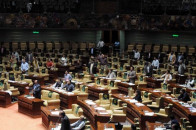
















COMMENTS
Comments are moderated and generally will be posted if they are on-topic and not abusive.
For more information, please see our Comments FAQ